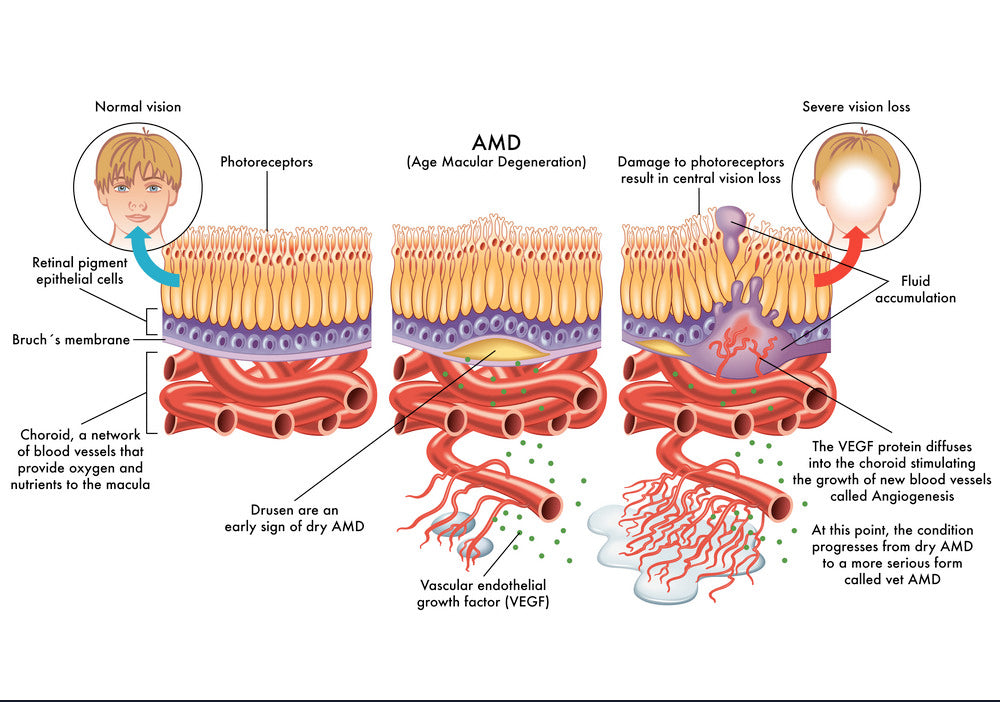Age-related Macular Degeneration – the leading cause of permanent loss of vision. Age-related Macular Degeneration – the leading cause of permanent loss of vision.
What is Age-Related Macular Degeneration?
Age-related macular degeneration (AMD) is an eye disease that is the leading cause of permanent vision loss for people above the age of 60.
AMD occurs when the central portion of the retina, called the macula, wears down.
The macula is the light-sensing nerve tissue in the eye. There are two main types of age-related macular degeneration:
- Dry form (geographic atrophy): Usually caused by thinning of the macula leading to dim or distorted vision, particularly while reading. Note: Supplementation only helps with dry form AMD.1
- Wet form (neovascular AMD): Generally caused by abnormal blood vessels that leak fluid or blood into the macula that could lead to scars and permanent loss of central vision.3
Most cases of AMD are dry form, but dry form can also lead to the wet form.
What are the major symptoms of AMD?
In general, symptoms of AMD include visual distortions, blurry or blind spots in field of vision and general haziness in overall vision.
Practically, individuals suffering from the onset of AMD may experience difficulty while driving or reading and find it more difficult to adapt to low-light conditions such as a dimly lit restaurant.
AMD often remains undetected until an advanced stage because the brain compensates for blind spots in the vision, so individuals do not realize that they cannot see clearly or are losing vision.
This also remains a reason why AMD remains so dangerous: it can only be diagnosed by a doctor and if it is too late, the nerve endings may not be able to be restored to regenerate vision.
Visit an ophthalmologist at the earliest if you notice changes in your central vision or your ability to see colours and fine details reduces – particularly if you are above 50.
What is the prevalence of AMD?
Age-related macular degeneration affects over 11 million people in the United States and 34 million people in Europe. It is estimated that by 2050, over 77 million Europeans will be affected by AMD. 4, 5, 6
How can AMD be cured?
While AMD cannot be cured, treatment can help slow down its onset or prevent serious loss of vision. Research has also found that individuals with dry AMD could slow down the disease by taking supplements of vitamin C, vitamin E, lutein, zeaxanthin, zinc, and copper.
Help Prevent AMD with Macusan
AGEPHA Pharma has the only multi-phase treatment for AMD prevention - targeted at patients in each different stages of AMD - with a series of three oral supplements that help maintain healthy lutein levels and reduce the chances of being affected by AMD.
Macusan tablets are nutritional supplements for the eyes which consist of multivitamins that increase retinal blood circulation including vitamin C, vitamin E, folic acid, zinc, copper, selenium, lutein, zeaxanthin, ginkgo biloba, and omega-3.7
Macusan, Macusan Plus, and Macusan AREDS2 are ideal for all AMD patients at any stage of progression to help maintain essential levels of nutrients

Sources:
What is Age-Related Macular Degeneration?
Age-related macular degeneration (AMD) is an eye disease that is the leading cause of permanent vision loss for people above the age of 60.
AMD occurs when the central portion of the retina, called the macula, wears down.
The macula is the light-sensing nerve tissue in the eye. There are two main types of age-related macular degeneration:
- Dry form (geographic atrophy): Usually caused by thinning of the macula leading to dim or distorted vision, particularly while reading. Note: Supplementation only helps with dry form AMD.1
- Wet form (neovascular AMD): Generally caused by abnormal blood vessels that leak fluid or blood into the macula that could lead to scars and permanent loss of central vision.3
Most cases of AMD are dry form, but dry form can also lead to the wet form.
What are the major symptoms of AMD?
In general, symptoms of AMD include visual distortions, blurry or blind spots in field of vision and general haziness in overall vision.
Practically, individuals suffering from the onset of AMD may experience difficulty while driving or reading and find it more difficult to adapt to low-light conditions such as a dimly lit restaurant.
AMD often remains undetected until an advanced stage because the brain compensates for blind spots in the vision, so individuals do not realize that they cannot see clearly or are losing vision.
This also remains a reason why AMD remains so dangerous: it can only be diagnosed by a doctor and if it is too late, the nerve endings may not be able to be restored to regenerate vision.
Visit an ophthalmologist at the earliest if you notice changes in your central vision or your ability to see colours and fine details reduces – particularly if you are above 50.
What is the prevalence of AMD?
Age-related macular degeneration affects over 11 million people in the United States and 34 million people in Europe. It is estimated that by 2050, over 77 million Europeans will be affected by AMD. 4, 5, 6
How can AMD be cured?
While AMD cannot be cured, treatment can help slow down its onset or prevent serious loss of vision. Research has also found that individuals with dry AMD could slow down the disease by taking supplements of vitamin C, vitamin E, lutein, zeaxanthin, zinc, and copper.
Help Prevent AMD with Macusan
AGEPHA Pharma has the only multi-phase treatment for AMD prevention - targeted at patients in each different stages of AMD - with a series of three oral supplements that help maintain healthy lutein levels and reduce the chances of being affected by AMD.
Macusan tablets are nutritional supplements for the eyes which consist of multivitamins that increase retinal blood circulation including vitamin C, vitamin E, folic acid, zinc, copper, selenium, lutein, zeaxanthin, ginkgo biloba, and omega-3.7
Macusan, Macusan Plus, and Macusan AREDS2 are ideal for all AMD patients at any stage of progression to help maintain essential levels of nutrients

Sources:
 This website is exclusively for European residents.
This website is exclusively for European residents. 

